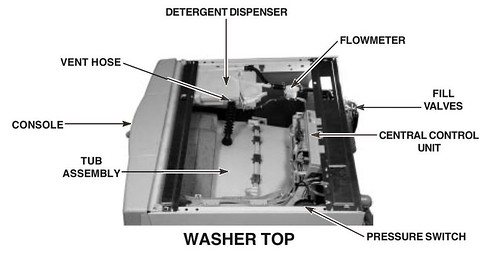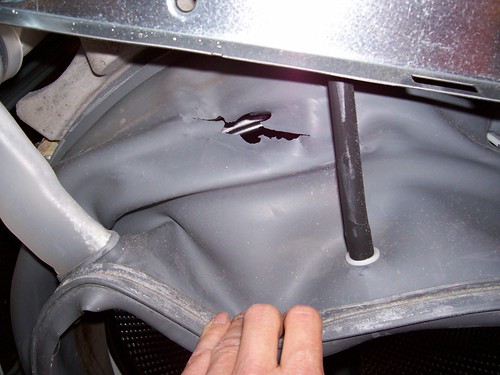I can’t remember the last time the major news media deigned to spill a little ink on us humble, hardworking (but damn good-looking) appliance repair guys. But the Washington Times recently ran an article about interesting trends in the appliance repair trade. And it wasn’t in the Obituary section, either! One of the outstanding features of this article is that it features some quotes by yours so very truly:
“It’s a dying trade,” said Scott Brown, Webmaster of www.fixitnow.com and self-proclaimed “Samurai Appliance Repairman.
”The reason for this is twofold,” Mr. Brown said, “The cost of appliances is coming down because of cheap overseas labor and improved manufacturing techniques, and repairmen are literally dying off.”
This is true as far as it goes, but he omitted the other side of the equation here, which is people’s perception of appliance repair technicians. Perception is important because if a person doesn’t trust the appliance servicer, then he will opt to buy a new appliance simply to avoid getting slimed by what he believes to be a sleazy servicer. To quote from my widely-acclaimed screed, Appliance Repair: A Dying Trade…
Appliance techs are already behind the eight ball the moment they walk in the customer’s house. Most people have been conditioned by 60 Minutes and other tabloid TV shows to view appliance repair techs as morally deficient cretins whose main objective in a service call is to screw the customer.
Granted, there are lots of charlatans and cretins out there, like this jive-turkey from Sears A&E. I get horror stories everyday by email or in the repair forum. But most independent appliance servicers are conscientious and highly skilled tradesmen who’ve invested thousands of hours learning the basic skills, keeping up with the new models, and honing their craft in the field.
The Washington Times article includes some interesting and revealing quotes from appliance service companies:
“Nowadays appliances are cheap, so people are just getting new ones,” said Paul Singh, a manager at the Appliance Service Depot, a repair shop in Northwest. “As a result, business has slowed down a lot.”
“The average repair cost for a household appliance is $50 to $350,” said Shahid Rana, a service technician at Rana Refrigeration, a repair shop in Capitol Heights. “If the repair is going to cost more than that, we usually tell the customer to go out and buy a new one.”
But wait! This is only true for cheap appliances! What if the customer has a $4,000 Dacor wall oven or a $3,000 Sub-Zero refrigerator? In these cases, even if the repair costs $700, you’re still better off repairing than buying a new one. Granted, you won’t be happy about it, but that’s the simple, economic reality. The mistake the Wash Times article makes is in not recognizing that low-end appliances and high-end appliances are two different worlds. In the former case, the trend is going exclusively to replace or DIY repairs; in the latter, there are ample opportunities to build a profitable service business provided your business is located in an area with lots of high-end appliances.
Appliance service companies who place absolute dollar limits on the cost of a repair without regard to the type of appliance being repaired deserve to go out of business. And building a service business around repairing lower-end appliances is a recipe for bankruptcy– these companies will go the way of the dinosaur and the VCR repair company. And they should. That’s why the free-market is so efficient at delivering goods and services– losers get pruned from the money tree. That’s another reason I recommend that service companies focus on servicing high-end appliances and leave the bottom-feeders to DIYers.
What we’re really seeing here is a stratification of the customer base: there are those who buy only the cheapest products and there are those who are willing to pay more. If you choose to buy lower-end appliances, plan on doing your own repairs because it simply won’t be cost-effective to have a professional technician repair it for you. That’s where Fixitnow.com comes in!
But suppose you pay $4,000 for a Miele or Dacor wall oven and it needs a repair after two or three years. In this case, throwing it out and getting a new one is simply not a reasonable option. And often, finding skilled technicians who work on the high-end brands can be difficult and will doubtless be more expensive. Once again, Samurai Appliance Repair Man gallops to the rescue by helping you fix it yourself. In addition to saving big bucks, fixing it yourself often results in a more timely, better quality repair than if you had hired a professional. How ‘bout them apples?
The Wash Times article continues:
It’s not uncommon for today’s repairmen to condemn an appliance instead of fixing it for the sake of their customers’ wallets.
If they decide to repair an appliance that is likely to break down again, repairmen are criticized by their customers and often lose business because of a damaged reputation.
Mr. Jones said he based his repair decisions on the 50 percent rule: “If the cost of service costs more than 50 percent of the price of a new machine, I’ll tell my customers to get a new one.”
More silliness. Mr. Jones’ rule-of-thumb fails to take into account the age of the appliance. If you have a two year old washing machine that cost $400 new and the repair costs $200, how does it make sense to junk it and buy a new $400 machine? Not only are you spending $200 more than you would for the repair, but what makes you think the new washer will last any longer than your existing one? Buying a new appliance in this situation is like cutting off your nose to spite your face.
The proper framework in which to think about the repair vs. replace question is by thinking in terms of Appliance Half-life®:
Appliance half-life is defined as the number of years after which it would not be cost-effective to repair half of the appliances in the group. For example, if the half-life of all dryers is 13 years, this means that in a group of 10 dryers, all 13-years old, it would be cost-effective to repair only five of them. The other five would be too badly deteriorated from abuse, poor quality, heavy use…whatever, to cost-effectively repair them. I have repaired dozens of 25-year old Whirlpool dryers that only needed minor repairs. I’ve also seen 10-year old Whirlpool dryers that were so far gone and would have needed such extensive repairs that I recommended the customer buy a new one. By the way, I’ve also seen 4-year old GE dryers that were ready for the trash heap the day they were built.
(For a more detailed explanation of Appliance Half-Life®, see this article.)
Continuing with the Wash Times article:
Mr. Brown acknowledged this trend. “Lower-end appliances which you can buy for $200 to $300 are basically throwaway appliances,” he said. “They are so inexpensive that you shouldn’t pay to get them repaired.”
He accurately quoted what I said you should not do in this case, but he omitted what I said you should do: fix it yourself! Doing the repair yourself definitely tilts the entire repair vs. replace question squarely into the repair camp, even for low-end, bottom-feeder brands and models. You can save hundreds of dollars doing your own repairs and that’s exactly what Fixitnow.com is all about.
Modern, energy-efficient refrigerators can cost as much as $5,000 to $10,000, and with such a hefty price tag, throwing one away is not an option.
In some cases, repairmen can help consumers reduce the amount of aggravation that a broken appliance will cause.
Consider the time and effort it takes to shop for a new appliance, wait for its delivery, remove the old one and get the new one installed.
In addition, certain appliances such as ovens and washing machines can be a bigger hassle to replace because they are connected to gas and water lines.
“It takes your time, it takes your effort, and if you don’t install the new appliance, you’ll have to hire a service technician to install it anyways,” Mr. Brown said.
I label this cost as “aggra-dollars.” That is, the aggravation and time spent that goes along with shopping for a new appliance, having it delivered, getting it installed, and disposing of your old one. If you’ve not experienced this joy recently, you’ll realize that the aggra-dollar factor can be a very significant cost.
Interestingly, the Reason.com blog picked up on this story and posted a commentary on it. I’m usually impressed with Reason’s analysis of economic issues and am squarely in the small-L libertarian camp on all issues, social and economic. But, in this case, Reason’s Nick Gillespie missed the bigger picture:
Every revolution has its casualties, and this fascinating Wash Times article points to a quiet, barely-noticed increase in the quality and longevity of household appliances.
Hello? This statement makes me wonder if Mr. Gillespie really owns any appliances! The reality is that, for appliances built today, you’ll be doing some type of repair on them every two to four years, regardless of brand. This is an industry average across all brands so some models will require more frequent repairs and others less. The real variable among brands is how severe that repair will be. For example, will you be replacing the motor in your dryer ($100 part) vs. just the thermal fuse ($25 part). Anyone who’s purchased a new appliance in the last ten years has experienced this first-hand. And we professional appliantologists have been seeing this trend for about ten years now.
So, tip o’ the hat to Bryce Baschuk at the Washington Times for starting a serious conversation on this topic. Also, the few times I’ve seen appliance techs discussed in Big Media was for the sole purpose of portraying us as a bunch of slimey, thieving cretins out to screw the customer. Kudos to Bryce for bucking that trend and portraying us techs in a sympathetic, if not positive, light.







